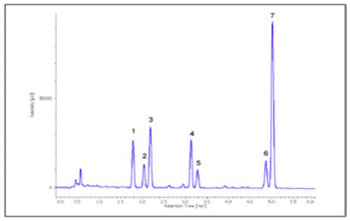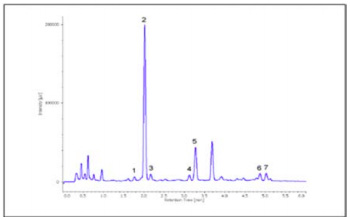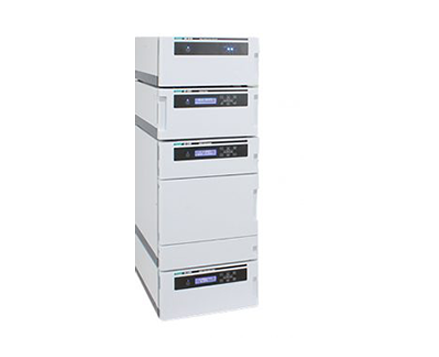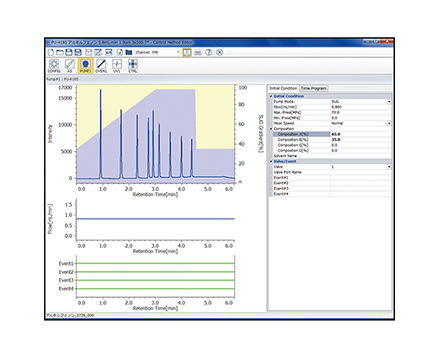High Speed Separation of Catechins by X-LC
January 5, 2024
Introduction
The main components of catechins in green tea include epicatechin (EC), epigallocatechin (EGC, hydroxy derivative of EC), epicatechin gallate (ECg, gallic acid ester of EC), and epigallocatechin gallate (EGCg, gallic acid ester of EGC).
We examined the applicability of X-LC for ultra-high speed analysis of 7 components: the 4 catechins listed above, catechin(C), catechin gallate(Cg), and caffeine.
Experimental

The system utilized in this experiment was a JASCO X-LC system consisting of two 3185-PU pumps, a 3080-DG degasser, a 3180-MX mixing unit, a 3067-CO column oven, a 3070-UV UV/Vis detector, a 3059-AS autosampler, and ChromNAV chromatography data system.
A commercially-available tea beverage was filtered with 0.2 µm membrane filter. A portion of the filtrate was injected.
Keywords
520015X
Results
Figure 1 shows an X-LC chromatogram of a standard mixture of 7 catechins. These components were clearly separated within 5 minutes by using a gradient elution method.

Peaks: 1=Epigallocatechin (500 µg/mL), 2=Caffeine (10 µg/mL), 3=Catechin (100 µg/mL), 4=Epicatechin (100 µg/mL), 5=Epigallocatechin gallate (25 µg/mL), 6=Epicatechin gallate (20 µg/mL), 7=Catechin gallate (100 µg/mL) Conditions: Column = X-PressPak AQ-C18W (2 mmID x 50 mmL, 2 µm), Column temperature = 30°C – Mobile phase: A = 0.2% phosphoric acid / acetonitrile (90/10), B = 0.2% phosphoric acid /acetonitrile (50/50), 0 min = A/B(100/0) – 0.5 min = A/B(100/0) – 4.0 min = A/B(70/30) – 5.0 min = A/B(70/30) – 5.05 min = A/B(100/0) – Flow late = 0.7 mL/min, Detection wavelength = 280 nm, Injection volume = 1 µL.
Figure 2 shows an X-LC chromatogram of the tea sample. Each component is well separated from unknown peaks.

Conditions: the same as in the Figure 1.
Featured Products:

High Speed Separation of Catechins by X-LC
Introduction
The main components of catechins in green tea include epicatechin (EC), epigallocatechin (EGC, hydroxy derivative of EC), epicatechin gallate (ECg, gallic acid ester of EC), and epigallocatechin gallate (EGCg, gallic acid ester of EGC).
We examined the applicability of X-LC for ultra-high speed analysis of 7 components: the 4 catechins listed above, catechin(C), catechin gallate(Cg), and caffeine.
Experimental

The system utilized in this experiment was a JASCO X-LC system consisting of two 3185-PU pumps, a 3080-DG degasser, a 3180-MX mixing unit, a 3067-CO column oven, a 3070-UV UV/Vis detector, a 3059-AS autosampler, and ChromNAV chromatography data system.
A commercially-available tea beverage was filtered with 0.2 µm membrane filter. A portion of the filtrate was injected.
Keywords
520015X
Results
Figure 1 shows an X-LC chromatogram of a standard mixture of 7 catechins. These components were clearly separated within 5 minutes by using a gradient elution method.

Peaks: 1=Epigallocatechin (500 µg/mL), 2=Caffeine (10 µg/mL), 3=Catechin (100 µg/mL), 4=Epicatechin (100 µg/mL), 5=Epigallocatechin gallate (25 µg/mL), 6=Epicatechin gallate (20 µg/mL), 7=Catechin gallate (100 µg/mL) Conditions: Column = X-PressPak AQ-C18W (2 mmID x 50 mmL, 2 µm), Column temperature = 30°C – Mobile phase: A = 0.2% phosphoric acid / acetonitrile (90/10), B = 0.2% phosphoric acid /acetonitrile (50/50), 0 min = A/B(100/0) – 0.5 min = A/B(100/0) – 4.0 min = A/B(70/30) – 5.0 min = A/B(70/30) – 5.05 min = A/B(100/0) – Flow late = 0.7 mL/min, Detection wavelength = 280 nm, Injection volume = 1 µL.
Figure 2 shows an X-LC chromatogram of the tea sample. Each component is well separated from unknown peaks.

Conditions: the same as in the Figure 1.

 Download This Application
Download This Application

